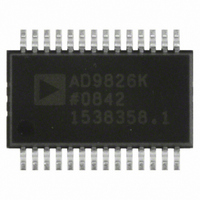AD9826KRSZ Analog Devices Inc, AD9826KRSZ Datasheet - Page 16

AD9826KRSZ
Manufacturer Part Number
AD9826KRSZ
Description
IC IMAGE SGNL PROC 16BIT 28-SSOP
Manufacturer
Analog Devices Inc
Type
Image Sensorr
Datasheet
1.AD9826KRSZRL.pdf
(20 pages)
Specifications of AD9826KRSZ
Input Type
Logic
Output Type
Logic
Interface
3-Wire Serial
Current - Supply
75mA
Mounting Type
Surface Mount
Package / Case
28-SSOP
Ic Interface Type
Serial
Supply Voltage Range
4.75V To 5.25V, 3V To 5.25V
Power Dissipation Pd
400mW
Operating Temperature Range
-40°C To +85°C
Digital Ic Case Style
SSOP
No. Of Pins
28
Lead Free Status / RoHS Status
Lead free / RoHS Compliant
Available stocks
Company
Part Number
Manufacturer
Quantity
Price
Company:
Part Number:
AD9826KRSZ
Manufacturer:
AD
Quantity:
5 510
Part Number:
AD9826KRSZ
Manufacturer:
ADI/亚德诺
Quantity:
20 000
Part Number:
AD9826KRSZ-REEL
Manufacturer:
ADI/亚德诺
Quantity:
20 000
Company:
Part Number:
AD9826KRSZRL
Manufacturer:
ST
Quantity:
2 904
Part Number:
AD9826KRSZRL
Manufacturer:
ADI/亚德诺
Quantity:
20 000
AD9826
CIRCUIT OPERATION
Analog Inputs—CDS Mode Operation
Figure 12 shows the analog input configuration for the CDS
mode of operation. Figure 13 shows the internal timing for the
sampling switches. The CCD reference level is sampled when
CDSCLK1 transitions from high to low, opening S1. The CCD
data level is sampled when CDSCLK2 transitions from high to
low, opening S2. S3 is then closed, generating a differential
output voltage representing the difference between the two
sampled levels.
The input clamp is controlled by CDSCLK1. When CDSCLK1
is high, S4 closes and the internal bias voltage is connected to
the analog input. The bias voltage charges the external 0.1 F
input capacitor, level-shifting the CCD signal into the AD9826’s
input common-mode range. The time constant of the input
clamp is determined by the internal 5 k resistance and the
external 0.1 F input capacitance.
1 F
SIGNAL
+
CCD
0.1 F
0.1 F
OFFSET
VINR
AD9826
S4
(INTERNAL)
5K
CDSCLK2
CDSCLK1
4V
3V
Q3
S1, S4 CLOSED
1.7k
2.2k
6.9k
S1
S2
INPUT CLAMP LEVEL
IS SELECTED IN THE
CONFIGURATION
REGISTER
S1, S4 OPEN
S2 OPEN
S3 OPEN
S3
4pF
4pF
S2 CLOSED
CML
CML
S3 CLOSED
External Input Coupling Capacitors
The recommended value for the input coupling capacitors is
0.1 F. While it is possible to use a smaller capacitor, this larger
value is chosen for several reasons:
Crosstalk
The input coupling capacitor creates a capacitive divider with
any parasitic capacitance between PCB traces and on chip traces.
C
order to minimize this effect. For example, with a 100 pF input
capacitance and just a few hundred f F of parasitic capacitance
on the PCB and/or the IC the imaging system could expect
to have hundreds of LSBs of crosstalk at the 16 b level. Using
a large capacitor value = 0.1 F will minimize any errors due
to crosstalk.
Signal Attenuation
The input coupling capacitor creates a capacitive divider with a
CMOS integrated circuit’s input capacitance, attenuating the
CCD signal level. C
input capacitance in order to minimize this effect.
Linearity
Some of the input capacitance of a CMOS IC is junction capaci-
tance, which varies nonlinearly with applied voltage. If the input
coupling capacitor is too small, then the attenuation of the CCD
signal will vary nonlinearly with signal level. This will degrade
the system linearity performance.
Sampling Errors
The internal 4 pF sample capacitors have a “memory” of the
previously sampled pixel. There is a charge redistribution error
between C
to-pixel voltage swings. As the value of C
resulting error in the sampled voltage will increase. With a C
value of 0.1 F, the charge redistribution error will be less than
1 LSB for a full-scale pixel-to-pixel voltage swing.
S1, S4 CLOSED
IN
should be large relative to these parasitic capacitances in
IN
and the internal sample capacitors for larger pixel-
S2 CLOSED
IN
should be large relative to the IC’s 10 pF
S3 CLOSED
IN
is reduced, the
IN













